Čáslav | |
|---|---|
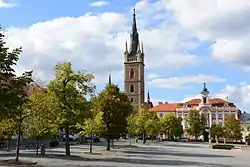 Jana Žižky z Trocnova Square with the town hall and Church of Saints Peter and Paul | |
 Flag 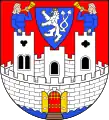 Coat of arms | |
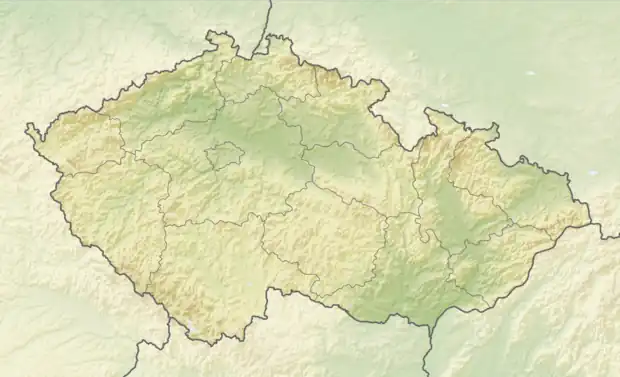 Čáslav Location in the Czech Republic | |
| Coordinates: 49°54′42″N 15°23′42″E / 49.91167°N 15.39500°E | |
| Country | |
| Region | Central Bohemian |
| District | Kutná Hora |
| First mentioned | 1052 |
| Government | |
| • Mayor | Jaromír Strnad |
| Area | |
| • Total | 26.46 km2 (10.22 sq mi) |
| Elevation | 231 m (758 ft) |
| Population (2023-01-01)[1] | |
| • Total | 10,468 |
| • Density | 400/km2 (1,000/sq mi) |
| Time zone | UTC+1 (CET) |
| • Summer (DST) | UTC+2 (CEST) |
| Postal code | 286 01 |
| Website | www |
Čáslav (Czech pronunciation: [ˈtʃaːslaf]; German: Tschaslau) is a town in Kutná Hora District in the Central Bohemian Region of the Czech Republic. It has about 10,000 inhabitants. The historic town centre is well preserved and is protected by law as an urban monument zone.
Administrative parts
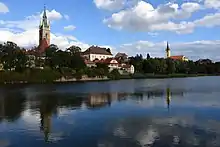
Čáslav is made up of town parts of Čáslav-Nové Město ("New Town") and Čáslav-Staré Město ("Old Town"), and of village of Filipov.
Geography
Čáslav is located about 9 kilometres (6 mi) southeast of Kutná Hora and 30 km (19 mi) southwest of Pardubice. It lies in a flat agricultural landscape of the Central Elbe Table. The Brslenka Stream flows through the town and supplies several ponds, including Podměstský in the town centre. The Klejnárka River crosses the western part of the municipal territory.
History
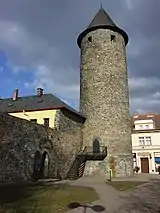
The history of Čáslav begins in the 9th century with the founding of a gord and settlement called Hrádek. In the 11th century, it became a Přemyslid administrative centre. A new royal town with a huge square was founded by King Ottokar II of Bohemia next to Hrádek in around 1250. In 1421, Bohemian parliament debated in Čáslav and voted in a new Hussite government.[2]
Two large fires in 1452 and 1522 severely damaged the town. During the Thirty Years' War, in 1639 and 1642, Čáslav was devastated and burnt down by Swedish troops. The town however recovered and in 1715, Čáslav became the centre of a region.[2]
Jewish population
From the 14th century there was a Jewish settlement in Čáslav, but in the 15th century the Jews were expelled. In the middle of the 19th century, only one Jewish family lived in the town. After the equality of the Jews in 1867, many from the area moved to the town of Čáslav. Around 1893, 245 Jews lived in the town, which was about 1–2% of the population.[3]
Demographics
|
|
| ||||||||||||||||||||||||||||||||||||||||||||||||||||||
| Source: Censuses[4][5] | ||||||||||||||||||||||||||||||||||||||||||||||||||||||||
Air base
To the northeast of the town, there is an active air base of the Czech Air Force, called the 21st Tactical Air Force Base. This base is responsible for protecting the airspace of the Czech Republic.[6]
Transport
Čáslav is located on the interregional railway line Prague–Žďár nad Sázavou. It is also the starting point of a line of local importance to Třemošnice.[7]
Sport
The town's football club, FK Čáslav, plays on the fourth tier of the Czech football system.
Notable is the Athletics Club Čáslav. Two of its most known sportswomen are Ludmila Formanová and Jarmila Kratochvílová, both World Champions in 800 m sprint.[8]
Sights
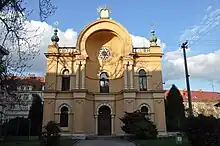
The Church of Saints Peter and Paul is an early Gothic building from the end of the 13th century. The building included the Romanesque Church of St. Michael from the 11th century (today's sacristy), which originally stood here.[2]
The town area was delimited by walls, which are preserved in one third of their original length. A unique monument of the Čáslav Gothic fortifications is the cylindrical Otakar's Tower, which stood at the Brod Gate.[2]
Čáslav Town Museum, one of the oldest regional museums in Bohemia, was founded in 1864. Its building is from 1884.[9]
The synagogue was built between 1899 and 1900 in Moorish style, designed by architect Wilhelm Stiassny. It was used until 1939 by the local Jewish community, which was then almost totally wiped out during the Holocaust. After World War II the abandoned building saw use as a warehouse, and then (between 1970–1989) as a gallery. In 1994, however, it was returned to the Jewish Community in Prague and has recently been restored.[3]
In 1910, part of the skull of famous Hussite general Jan Žižka was discovered in Čáslav parish church. The skull is exhibited in Žižka's Hall of Čáslav Town Hall.[10]
Notable people
- Jan Ladislav Dussek (1760–1812), composer and pianist
- Jan Karafiát (1846—1929), calvinistic priest and children writer
- Antonín Chittussi (1847–1891), Impressionist painter
- Rudolf Těsnohlídek (1882–1928), writer
- Jiří Mahen (1882–1939), writer
- František Moravec (1895–1966), military intelligence officer
- Josef Svoboda (1920–2002), scenographer
- Eli Urbanová (1922–2012), poet, novelist and Esperantist
- Antonín Rükl (1932–2016), astronomer
- Miloš Forman (1932–2018), film director
- Jarmila Kratochvílová (born 1951), athlete
- Ludmila Formanová (born 1974), athlete
- David Jarolím (born 1979), footballer
Twin towns – sister cities
.svg.png.webp) Opfikon, Switzerland
Opfikon, Switzerland
References
- ↑ "Population of Municipalities – 1 January 2023". Czech Statistical Office. 2023-05-23.
- 1 2 3 4 "Historie" (in Czech). Město Čáslav. Retrieved 2022-05-23.
- 1 2 "Čáslavská synagoga a její architekt Wilhelm Stiassny" (in Czech). Čáslav Town Museum. Retrieved 2021-07-02.
- ↑ "Historický lexikon obcí České republiky 1869–2011 – Okres Kutná Hora" (in Czech). Czech Statistical Office. 2015-12-21. pp. 1–2.
- ↑ "Population Census 2021: Population by sex". Public Database. Czech Statistical Office. 2021-03-27.
- ↑ "21st Tactical Air Force Base – #WeAreNATO". Ministry of Defence of the Czech Republic. 2019-05-28. Retrieved 2023-10-31.
- ↑ "Detail stanice Čáslav" (in Czech). České dráhy. Retrieved 2023-10-31.
- ↑ "Základní informace" (in Czech). Město Čáslav. Retrieved 2021-07-02.
- ↑ "Městské muzeum Čáslav" (in Czech). Čáslav Town Museum. Retrieved 2021-07-02.
- ↑ "Čáslavská radnice vystavuje lebku Jana Žižky. Jsou vidět zranění, která ho oslepila" (in Czech). Czech Radio. 2021-07-07. Retrieved 2021-07-02.
- ↑ "Partnerská města" (in Czech). Město Čáslav. Retrieved 2020-08-05.